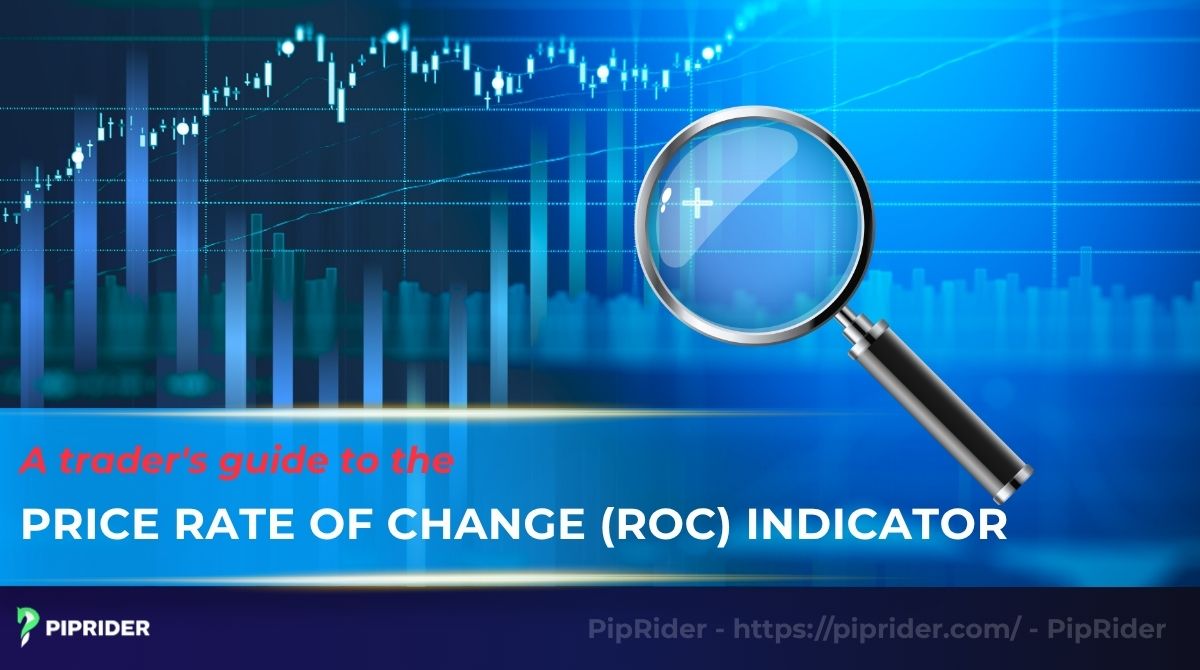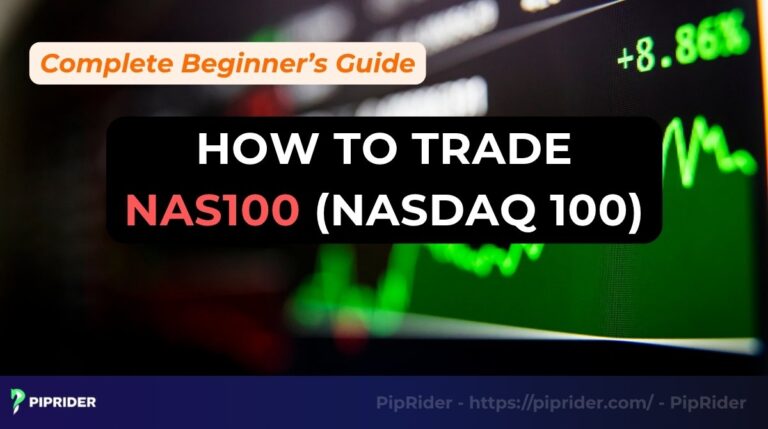Determining the precise moment a trend loses its momentum is a critical challenge in trading. Price movement alone can be ambiguous; successful decision-making, especially regarding profit-taking, requires quantifying market speed.
The Price Rate of Change (ROC) indicator solves this by acting as a pure momentum tool. It directly measures the velocity of price changes, allowing traders to objectively confirm trend strength and anticipate potential exhaustion points.
This guide provides the complete formula, clear interpretation rules, and practical strategies for integrating the ROC into your analysis today.
Key Takeaways
- The Price Rate of Change measures the percentage change in price from a previous period.
- Its main functions are to identify overbought/oversold conditions, spot divergences, and confirm trends.
- Unlike the RSI, the ROC uses a centerline at zero and is unbounded.
- The most fundamental signals are when the indicator crosses above the zero line or below it.
- Though powerful, this indicator can be choppy and give false signals.
1. What is the Price Rate of Change?
The Price Rate of Change (ROC) is a foundational momentum indicator used to measure the rate and strength of price changes over a specified look-back period. It provides one of the most direct and clear readings of underlying market momentum for technical analysis.(StockCharts, n.d.).
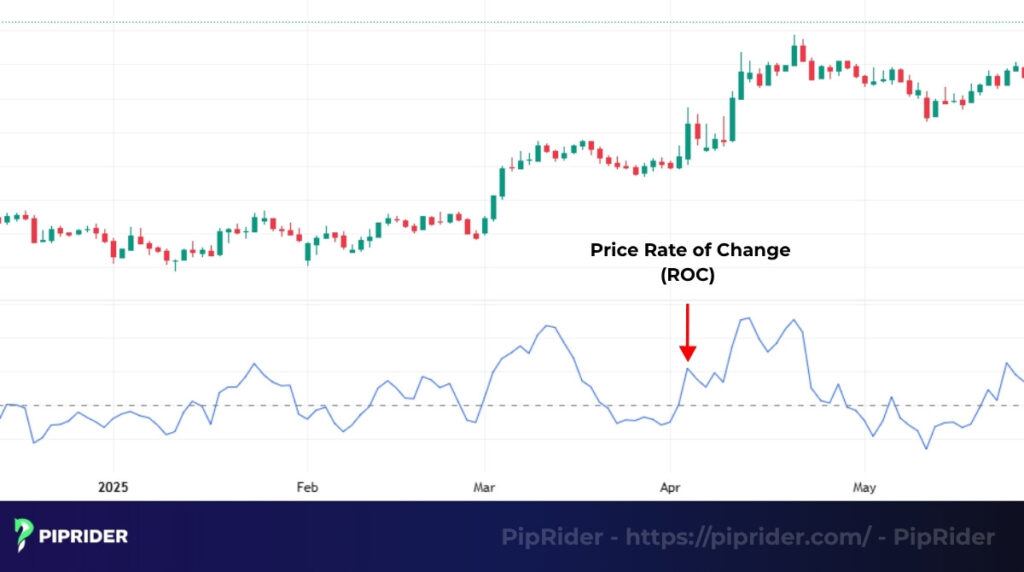
The sole purpose of this tool is to measure the percentage change in price over a specific time period. Put simply, it helps traders answer the question, “Is the price moving faster or slower now than before?”
Imagine a sprinter running a race. The ROC doesn’t just tell you if the sprinter is moving forward; it tells you if they are speeding up or getting tired and slowing down.
This is crucial for traders. An upward-sloping line suggests that the rate of price increase is accelerating, indicating strengthening momentum. A falling line is a warning sign that the trend is losing momentum and may be vulnerable to a reversal, impacting the ability to trade trends.
2. The ROC formula and calculation
This section details the straightforward formula used to calculate the Price Rate of Change (ROC), step by step guide to calculate and simple example.
2.1. The Rate of Change formula
The formula is designed to give traders a simple percentage that shows how much the price has changed over a specific lookback period. The standard formula for the Rate of Change is as follows:
| ROC = [(Current Closing Price – Closing Price ‘n’ periods ago) / (Closing Price ‘n’ periods ago)] x 100 |
This calculation produces a line that oscillates above and below a central point at zero (Investopedia, n.d.).
Common lookback periods of ROC
The lookback period (n) traders select for the Rate of Change (ROC) indicator should directly align with their trading strategy and goals.
- Short periods (7-14 days): Highly responsive, suitable for short-term trading.
- Medium periods (14-36 days): Provides a good balance, ideal for swing trading.
- Long periods (36-200 days): The signal is smoother and used for identifying long-term trends.
2.2. The calculation process in simple steps
Let’s simplify that calculation into three easy-to-follow steps.
Step 1: First, it gets the current price
The indicator takes the most recent closing price of the asset traders are analyzing.
Step 2: Then, it looks back in time
It finds the closing price from ‘n’ periods ago. The ‘n’ is the only setting traders need to worry about, with a common default being 12 or 14 periods. A shorter lookback period increases its volatility and sensitivity. So on a daily chart, it would look at the price from 12 days ago.
Step 3: Finally, the percentage change is calculated
The difference between the new and old price is taken, divided by the old one, and then converted to a percentage through multiplication by 100. A positive outcome places the ROC line above its central point, which signifies an uptrend. A negative result means the ROC line is below its central point, indicating bearish momentum.
2.3. A simple example
To illustrate, let’s calculate a 12-period for a hypothetical stock and its holding period.
| Day | Closing Price | Price 12 Days Ago | Calculation | Resulting ROC |
| … | … | … | … | … |
| Day 13 | $105 | $100 (Price on Day 1) | [($105 – $100) / $100] x 100 | +5.00 |
| Day 14 | $108 | $101 (Price on Day 2) | [($108 – $101) / $101] x 100 | +6.93 |
| Day 15 | $109 | $105 (Price on Day 3) | [($109 – $105) / $105] x 100 | +3.81 |
Notice how the ROC rose from +5.00 to a peak of +6.93 on day 14, showing that bullish momentum was accelerating strongly.
However, on day 15, even though the price made a new high at $109, the ROC fell sharply to +3.81. This is a classic example of bearish divergence, a powerful early warning that despite the new high price, the momentum behind the trend is weakening significantly.
3. How to use the ROC in trading
With the mechanics understood, let’s move to the practical part. Interpreting signals from the ROC indicator is how this tool becomes a powerful analytical asset. The ROC provides four key signals, and it is crucial to understand what each one is telling traders about market momentum.
3.1. Zero line crosses
Zero-line is the dividing wall between positive (bullish) and negative (bearish) momentum. The crossover of this line is the most fundamental signal the ROC provides.

- A move above the zero line signals a bullish trend, showing that current prices are higher than they were previously.
- A move below the zero line signals a bearish trend, indicating that sellers are gaining control.
A word of caution: This signal is most reliable for confirming new trends, not for trading choppy, ranging markets which can produce many false signals.
3.2. Overbought and oversold conditions
This is where the ROC differs from an indicator like the RSI. Unlike the RSI, the ROC does not have predefined overbought or oversold thresholds like 70 and 30. Traders have to determine these levels for themselves.
- To do this, traders must look at the historical data for the specific asset they are trading. Look back and see what extreme levels the ROC has reached in the past before reversing. These historical extremes become their custom overbought and oversold zones.
- The signal is not when the ROC enters an extreme zone, but when it begins to turn back and exit that zone. This indicates that the extreme momentum is starting to fade.
3.3. Divergences
Divergence is one of the most effective ways to use the Price Rate of Change. A divergence is a disagreement between price and momentum, and it’s often a potent early warning of a potential trend reversal in trends.
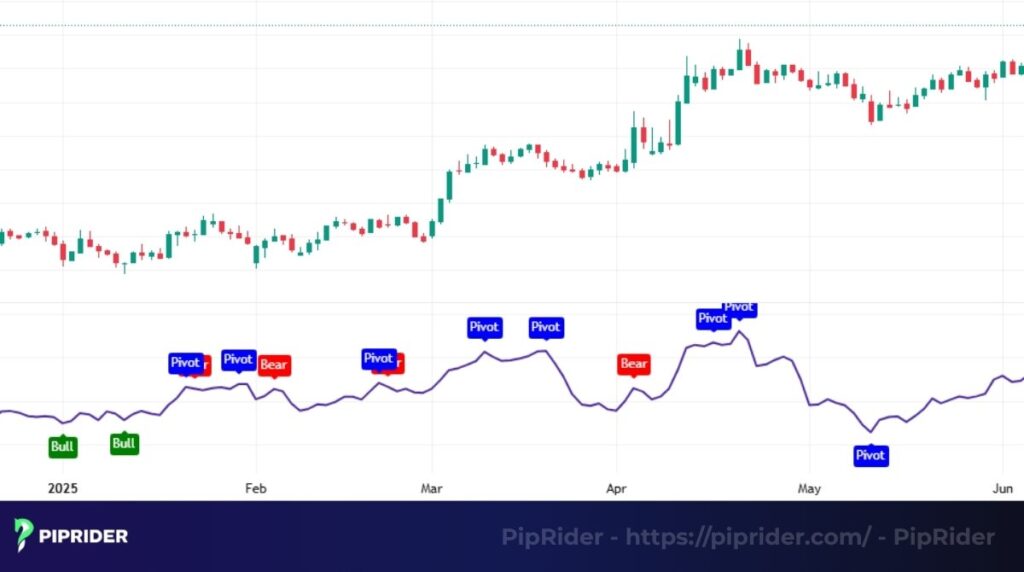
- A bearish divergence forms when the price on the chart forges a new high, while the ROC indicator simultaneously fails to do so, creating a lower high instead. This is a major red flag, suggesting that even though the price looks bullish, the bearish momentum behind the move is weakening.
- Bullish divergence happens when the price makes a new low, but the ROC makes a higher low. This tells you that selling pressure is becoming exhausted, even as the price is falling.
3.4. Breakout confirmation
The ROC is an excellent tool for helping traders distinguish between a genuine breakout and a frustrating “fakeout”. A legitimate price breakout should be validated by a strong increase in momentum.
- When traders see the price break resistance levels, glance down at the ROC. Is the line also surging upwards and making a new high? If so, that’s a strong confirmation that the breakout has real power behind it.
- If the price breaks out but the indicator is flat or falling (a form of divergence), traders should be extremely cautious. This often signals a lack of conviction that can lead to a quick reversal.
4. ROC scanner and screener examples
Once you’re comfortable reading the ROC indicator on a single chart, the next step is applying its power to scan the entire market for opportunities. This is done with a tool called a scanner.
A scanner is an automated tool on platforms such as TradingView or Finviz, filtering thousands of assets (e.g., forex pairs or stocks) in real-time to find those that meet your criteria. It’s like having a team of analysts working for you 24/7.
Here are a few practical examples of how to use ROC in a scanner to find high-probability setups.
4.1. Scanning for strong momentum breakouts
Scanning for strong momentum breakouts is a classic trend-following scan. The objective is to identify assets already in an uptrend that are also showing signs of accelerating bullish momentum.
- The logic: Find a stock or forex pair that is already in an established uptrend and is now showing a fresh burst of momentum. This is often a sign that the trend is about to continue with force, which often precedes periods of high volatility.
- The scanner settings:
- Price: is above its 50-day moving average (our trend filter).
- ROC (12-period): has just crossed above its centerline.
- Volume: is above its 20-day average (for volume confirmation and institutional interest).
This scan will give traders a small, manageable list of assets that are in a confirmed uptrend and are showing signs of accelerating momentum right now.
4.2. Scanning for potential bullish divergences
Scanning for potential bullish divergences is a more advanced, contrarian scan. The goal is to find assets that are in a downtrend but are showing signs of bottoming out as the selling momentum fades.
- The logic: Looking for that powerful disagreement between price and momentum. This scan helps us find potential “falling knives” that might actually be safe to catch.
- The scanner settings:
- Price: has made a new 20-day low (confirming the price is still weak).
- ROC (12-period): is currently higher than it was 20 days ago (this is a simple way to screen for potential divergence).
- RSI (14-period): is below 30 (to confirm an oversold condition).
This scan will find assets that are beaten down but are showing early, under-the-surface signs of strength. These are not immediate buy signals, but they give traders a fantastic “watch list” of potential reversal candidates to analyze further.
5. Price Rate of Change strategy in Forex
An indicator is only valuable when it’s part of a well-defined forex trading strategy. A strategy provides rules for entry, exit, and risk management, which is what separates disciplined trading from gambling. Let’s walk through two simple yet effective strategies that traders can use as a starting point for incorporating the ROC indicator into their own trading.
5.1. Strategy 1: The trend-following zero-line crossover
The trend-following zero-line crossover is a classic trend-following strategy. Its goal is to use the ROC’s most basic signal to join a trend that has just confirmed its momentum.

- The logic: Use a long-term moving average (like the 200 EMA) to define the overall market price direction. Then only take ROC signals that align with that primary trend, filtering out low-probability counter-trend signals.
- The rules for a buy trade:
- Trend filter: The price must be trading above the 200 EMA, and the EMA should be sloping upwards.
- The entry trigger: Wait for the ROC to move from below the zero-line to above it.
- Entry: Enter a buy trade at the open of the next candle after the indicator has confirmed its cross.
- Stop loss: Place your stop loss below the most recent swing low.
- Take profit: Set the profit target at a key resistance level visible on the chart, or use a fixed risk-to-reward ratio, for example, 1:1.5 or 1:2.
5.2. Strategy 2: The divergence reversal
The divergence reversal is a more advanced strategy aimed at catching potential trend shifts. It’s based on the powerful divergence signal.
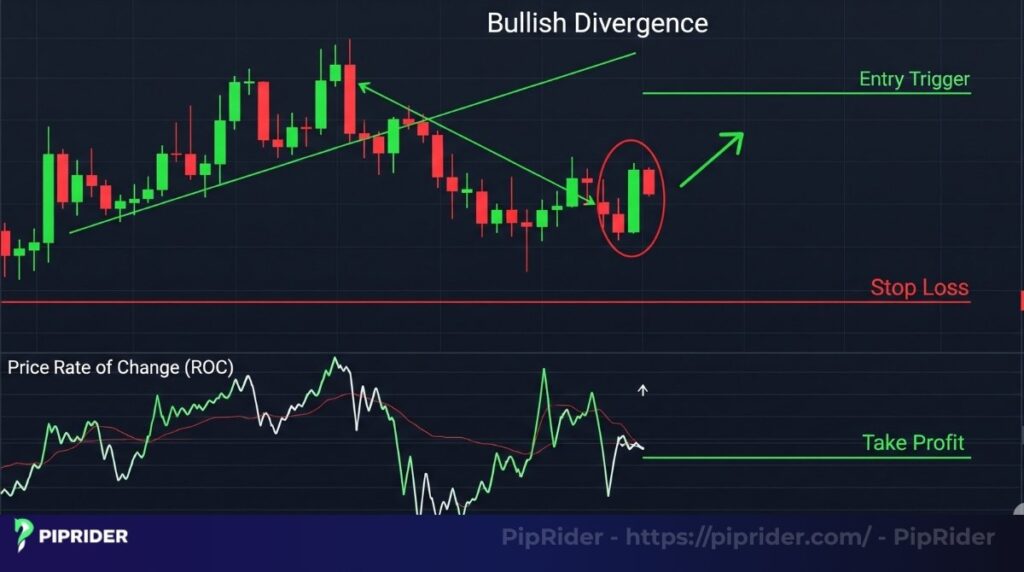
- The logic: Looking to spot a clear disagreement between price and momentum at a logical turning point on the chart, such as a key support or resistance level.
- The rules for bullish reversals (buy trade):
- Spot the divergence: Look for an instance where price creates a new lower low, but the ROC indicator prints a higher one at the same time.
- Price action confirmation: Confirmation is a crucial step. Wait for a strong candle to form, using pattern recognition to confirm the move (e.g., a pin bar or a bullish engulfing pattern). This indicates that buyers are stepping in.
- Entry: Enter a long trade after the strong candle has closed.
- Stop loss: Place the stop loss just below the absolute low of the move.
- Take profit: Since this is a strategy to catch a reversal, a logical first target would be the nearest significant resistance level where the asset might struggle.
6. ROC vs. other momentum indicators
The world of momentum indicators is crowded, and it’s easy to get confused between tools like the ROC, RSI, and MACD. While they all measure momentum, they do so in fundamentally different ways, making them suited for different tasks.
The best way to understand their roles is to see them side-by-side. The ROC is a pure, direct measure of price change, while others add layers of smoothing or different calculations. Keep in mind that the ROC, while fast, is still a lagging indicator because it uses past price data.
This brief comparison table can help you select the appropriate tool for your needs.
| Feature | ROC (Rate of Change) | RSI (Relative Strength Index) | MACD (Moving Average Convergence Divergence) |
| What it Measures | Measures the raw percentage change in price over a defined period. | The speed and magnitude of price changes, balancing gains vs. losses. | Shows the relationship between two MAs to define trend and momentum. |
| Centerline | Zero Line (0) | 50 Line | Zero Line (0) |
| Scale | Unbounded (can go infinitely high or low). | Bounded (0 to 100). | Unbounded. |
| Primary Use | Identifying raw momentum, divergence, and centerline crossovers. | Identifying overbought/oversold condition (70/30) and divergence. | Identifying trend direction and strength through crossovers. |
| Behavior | Can be “choppy” and very responsive as it’s a raw calculation. | Smoother than ROC due to its internal formula. | The slowest and smoothest of the three, as it’s based on multiple MAs. |
| Suggestions | Ideal for a direct, unfiltered view of momentum and spotting divergence. | The best all-rounder for identifying overbought/oversold levels. | The best tool for confirming the direction and strength of an established trend. |
7. Frequently Asked Questions (FAQs)
8. Summary
In trading, understanding a trend’s direction is only half the battle; knowing its strength is the other half. The Price Rate of Change (ROC) indicator provides a simple and unfiltered way to measure that strength, acting as a true speedometer for market momentum.
While it can be prone to choppiness, its power lies in its simplicity. By using its zero-line crossovers to confirm trends and its divergence signals to warn of potential reversals, you can add a valuable layer of analysis to your trading.
This guide has given you the foundation. The next step is to apply this knowledge, backtest a strategy, and see how this classic indicator can enhance your trading strategies. To continue learning, explore our other guides in the best technical indicators category here on Piprider to see how the ROC indicator can be combined with other powerful tools.


